- Home
- Robert J. Sawyer
The Terminal Experiment (v5) Page 2
The Terminal Experiment (v5) Read online
Page 2
Peter paused, thinking back to how the whole damned thing had started. Another hospital room, trying to comfort another brave woman who was dying. It comes full circle.
“Sarkar Muhammed was right—I should have come to you before. I need your help, Sandra. This has to end.” Peter exhaled, wondering where to begin. So much had happened. “Did you know,” he said at last, “that it’s possible to scan every neural net in a human brain and produce an exact duplicate of the subject’s mind inside a computer?”
Sandra shook her head slightly.
“Well, it is. It’s a new technique. Sarkar Muhammed is one of its pioneers. What would you say if I told you that my brain had been scanned and duplicated?”
Sandra lifted her eyebrows. “Two heads … better than one.”
Peter acknowledged the comment with a wry smile. “Perhaps. Although, actually, a total of three simulations of me were made.”
“And one of these … committed … murders?”
Peter was surprised by how quickly Sandra grasped it. “Yes.”
“Thought AI … was involved.”
“We’ve tried to stop them,” said Peter. “Nothing worked. But at least I now know which simulation is guilty.” He paused. “I’ll give you everything you’ll need, Sandra, including full Q&A access to the scans of my brain. You’ll get to know me in intimate detail— better than anyone in the real world knows me. You’ll know how I think, and that will give you the knowledge to outwit the murdering simulation.”
Sandra lifted her shoulders slightly. “Nothing I can do,” she said, her voice weak and sad. “Dying.”
Peter closed his eyes. “I know. I’m terribly, terribly sorry. But there is a way, Sandra—a way for you to end all this.”
CHAPTER 1
January 1995
Sandra Philo probed the memories of Peter Hobson.
The horror, she learned, had started in 1995, sixteen years ago. Back then, Peter Hobson hadn’t been the center of a controversy about science and faith that was shaking the world. No, back then he was simply a twenty-six-year-old grad student at the University of Toronto, doing his master’s degree in biomedical engineering—a student who was about to have the shock of his life …
THE PHONE RANG in Peter Hobson’s dorm room. “We’ve got an eater,” said Kofax’s voice. “You up for it?”
An eater. A dead person. Peter was trying to get used to Kofax’s callousness. He rubbed sleep from his eyes. “Y-yes.” He tried to sound more confident: “Sure,” he said. “Sure thing.”
“Mamikonian’s going to start the slice-and-dice,” said Kofax. “You can ride the EKG. That’ll take a good hunk out of your practicum requirements.”
Mamikonian. Stanford-trained transplant surgeon. Sixty-something, hands steady as a statue’s. Organ harvesting. Christ, yes, he wanted in on that. “How soon?”
“Couple of hours,” said Kofax. “Kid’s on full life support—keep the meat fresh. Mamikonian is out in Mississauga; it’ll take him that long to get here and prepped.”
Kid, he’d said. Some kid’s life cut short.
“What happened?” asked Peter.
“Motorcycle accident—kid was thrown through the air when a Buick sideswiped him.”
A teenaged boy. Peter shook his head. “I’m in,” he said.
“OR 3,” said Kofax. “Start prep in an hour.” He hung up. Peter hurried to get dressed.
HE WASN’T SUPPOSED to do it, Peter knew, but he couldn’t help himself. On the way to the OR, he stopped at Emergency Admitting and checked the aluminum clipboards in the swivel-mounted rack. One guy being sewn up after going through a plate-glass window. Another with a broken arm. Knife wound. Stomach cramps. Ah—
Enzo Bandello, 17.
Motorcycle accident, just as Kofax had said.
A nurse sidled up to Peter and looked over his shoulder. Her name badge said Sally Cohan. She frowned. “Poor kid. I’ve got a brother the same age.” A pause. “The parents are in the chapel.”
Peter nodded.
Enzo Bandello, he thought. Seventeen.
In trying to save the boy, the trauma team had given him dopamine and had deliberately dehydrated him, in hopes of reducing the brain swelling normally associated with a severe head wound. Too much dopamine, though, would damage the heart muscle. According to the chart, at 2:14 a.m., they’d begun flushing it from his body and fluids were being pumped in. Latest reading showed his blood pressure was still too high—an effect of the dopamine—but it should come down soon. Peter flipped pages. A serology report: Enzo was free of hepatitis and AIDS. Blood count and bleeding studies looked good, too.
A perfect donor, thought Peter. Tragedy or miracle? His parts would save the lives of a half-dozen people. Mamikonian would take the heart out first, a thirty-minute operation. Then the liver—two hours’ work. Next, the renal team would remove the kidneys, another hour’s cutting. After that, the corneas. Then the bones and other tissues.
There wouldn’t be much left to bury.
“Heart’s going to Sudbury,” said Sally. “Crossmatching was excellent, they say.”
Peter put the clipboard back into the carousel and walked through the double doors that led to the rest of the hospital. There were two equally good routes to OR 3. He chose the one that went by the chapel.
He was not a religious person. His family, back in Saskatchewan, was white-bread Canadian Protestant. Last time Peter had been in church was for a wedding. Time before that, a funeral.
He could see the Bandellos from the hallway, seated in a middle pew. The mother was crying softly. The father had an arm around her shoulders. He was a deeply tanned man wearing a plaid work shirt with cement stains on it. A bricklayer, perhaps. A lot of Toronto’s Italians of his generation worked in construction. They’d come over after World War II, unable to speak English, and had taken hard-labor jobs to make a better life for their kids.
And now this man’s kid was dead.
The chapel was denominationally neutral, but the father was looking up, as if he could see a crucifix on the wall, see his Jesus hanging there. He crossed himself.
Somewhere in Sudbury, Peter knew, there was a celebration going on. A heart was coming; a life would be saved. Somewhere there was joy.
But not here.
He continued on down the corridor.
PETER ARRIVED at the scrub room. Through a large window, he could see into the operating theater. Most of the surgical team was already in place. Enzo’s body had been prepped: his torso shaved, two layers of rust-colored iodine painted on, clear plastic stretched over the surgical field.
Peter tried to get a look at that which the others had been trained to ignore: the face of the donor. Not much of it was visible; most of Enzo’s head was covered by a thin sheet, exposing only the ventilator tube. The transplant team was deliberately kept ignorant of the donor’s identity—made it easier, they said. Peter was probably the only one who knew the boy’s name.
There were two scrub sinks outside the OR. Peter began the regulation eight minutes of washing, a digital timer above the sink counting down the time.
After five minutes, Dr. Mamikonian himself arrived and began scrubbing at the second sink. He had steel-gray hair and a lantern jaw—more like an aging superhero than a surgeon.
“You are?” asked Mamikonian as he scrubbed.
“Peter Hobson, sir. I’m a grad student in biomedical engineering.”
Mamikonian smiled. “Good to meet you, Peter.” He continued to scrub. “Forgive me for not shaking hands,” he said, chuckling. “What’s your role today?”
“Well, for our course work we’re supposed to log forty hours of real-world experience with medical technology. Professor Kofax—he’s my thesis advisor—arranged for me to operate the EKG today.” He paused. “If that’s all right with you, sir.”
“That’s fine,” said Mamikonian. “Watch and learn.”
“I will, sir.”
The counter above Peter’s sink bleeped.
He wasn’t used to this; his hands felt raw. He held his dripping arms out at chest height. A scrub nurse appeared with a towel. Peter took it, dried his hands, then stepped into the sterile green gown she was holding for him.
“Glove size?” she asked.
“Seven.”
She tore open a package, removed the latex gloves, and snapped them onto his hands.
Peter entered the OR. Overhead, a dozen people were watching through the glass ceiling from the observation gallery.
In the center of the room was a table holding up Enzo’s body. There were several tubes going into it: three volume lines, an arterial line to monitor blood pressure, a central venous line threaded into the heart to monitor hydration level. A young Asian woman sat on a stool, her eyes scanning the volume monitor, the CO2 monitor, and the volumetric infusion pump.
Until his arrival, the woman had also been watching the EKG oscilloscope mounted above Enzo’s head. Peter moved into position next to it and adjusted the contrast on the display. The pulse rate was normal, and there was no sign of damage to the heart muscle.
It chilled him. The guy was legally dead, and still he had a pulse.
“I’m Hwa,” said the Asian woman. “First time?”
Peter nodded. “I’ve been in on a few little things before, but nothing like this.”
Hwa’s mouth was covered by a face mask, but Peter could see her eyes crinkle in a smile. “You get used to it,” she said.
Across the room, an illuminated panel had Enzo’s chest x-ray clipped to it. The lungs hadn’t collapsed and the chest was clear. The heart, a silhouette in the center of the image, looked fine.
Mamikonian entered. All eyes turned to face him—the conductor for their orchestra. “Good morning, everyone,” he said. “Let’s go to work, shall we?” He moved in to stand over Enzo’s body.
“Blood pressure’s falling a bit,” said Hwa.
“Crystalloid fluid, please,” said Mamikonian, glancing at the readouts. “And let’s add a little dopamine back in.”
Mamikonian stood on Enzo’s right, next to his chest. Across from him was the scrub nurse. A surgical assistant stood next to her, holding the abdominal-wall retractor. Five one-liter containers of ice-cold Ringer’s lactate were lined up in a neat row on a table so they could be emptied quickly into the chest cavity. A nurse also had six units of packed red blood cells ready to go. Peter tried to stay out of the way near the head of the bed.
Next to Peter, the perfusionist, a Sikh wearing a large green cap over his turban, scanned a series of readouts labeled remote temperatures, arterial vent, and cardiac sucker. Nearby, another technician carefully watched the rising and falling of the ventilator’s black bellows to make sure Enzo was still breathing properly.
“Let’s go,” said Mamikonian.
A nurse moved in and injected something into Enzo’s body. She spoke into a microphone dangled on a thin wire from the ceiling. “Myolock administered at 10:02 a.m.”
Dr. Mamikonian requested a scalpel and made an incision starting just below the Adam’s apple and continuing down the center of the chest. The scalpel split the skin easily, sliding through the muscle and fat until it banged against the breastbone.
The EKG shuddered slightly. Peter glanced at one of Hwa’s monitors: blood pressure was rising, too.
“Sir,” said Peter. “The heart rate is acting up.”
Mamikonian squinted at Peter’s oscilloscope. “That’s normal,” he said, sounding irritated at being interrupted.
Mamikonian handed the scalpel, now slick and crimson, back to the nurse. She passed him the sternal saw, and he turned it on. Its buzzing drowned out the blipping from Peter’s EKG. The saw’s rotating blade sliced through the sternum. An acrid smell rose from the body cavity: powdered bone. Once the sternum was cut apart, two technicians moved in with the chest spreader. They cranked it around until the heart, beating once per second, was visible.
Mamikonian looked up. On the wall was the digital ischemic counter; it would be started the moment he excised the organ, measuring the time during which there would be no blood flowing to the heart. Next to Mamikonian was a plastic bowl filled with saline. The heart would be rinsed in there to get old blood off it. It would then be transferred into an Igloo container filled with ice for the flight to Sudbury.
Mamikonian requested another scalpel and bent down to cut through the pericardium. And, just as his blade sliced through the membrane surrounding the heart—
The chest of Enzo Bandello, legally dead organ donor, heaved massively.
A gasp escaped from around his ventilator breathing tube.
A moment later, a second gasp was heard.
“Christ—” said Peter, softly.
Mamikonian looked irritated. He snapped his gloved fingers at one of the nurses. “More Myolock!”
She moved in and administered a second shot.
Mamikonian’s voice was sarcastic. “Let’s see if we can finish this damned thing without the donor walking away, shall we, folks?”
PETER WAS DAZED. Mamikonian departed with the excised heart. Since that meant there was no more need for an EKG operator, Peter went up to the observation level and watched the rest of the harvesting from there. When it was done—when Enzo Bandello’s hollow corpse was sewn shut and rolled off to the morgue— Peter staggered down to the scrub room. He found Hwa, who was pulling off her gloves.
“What happened in there?” Peter asked.
Hwa exhaled noisily; she was exhausted. “You mean the gasping?” She shrugged. “Happens every once in a while.”
“But, Enz—but the donor was dead.”
“Of course. But he was also on full life-support. Sometimes there’s a reaction.”
“And—and what was that business with Myolock? What’s that?”
Hwa was untying her surgical gown. “It’s a muscular paralyzer. They have to administer that. If they don’t, sometimes the donor’s knees tuck up toward the chest as
you carve into it.”
Peter was appalled. “Really?”
“Uh-huh.” Hwa dropped her gown into the hamper. “It’s just a muscular reaction. Nowadays, it’s routine procedure to anesthetize the corpse.”
“Anesthetize the corpse … ?” said Peter slowly.
“Yeah,” she said. “’Course, Dianne obviously didn’t do a good enough job today.” Hwa paused. “It gives me the willies when they start moving like that, but, hey, that’s transplant surgery for you.”
PETER KEPT a little copy of the timetable for his girlfriend, Cathy Churchill, in his wallet. He was in the first year of his master’s; she was in her last year of her bachelor’s in chemistry. She would be finishing her final class of the day—polymers—in about twenty minutes. He hurried back to the campus and waited in the hall outside the classroom for her.
The class ended and Cathy came out, chatting animatedly with her friend Jasmine, who caught sight of Peter first. “Well,” she said, grinning, and tugging Cathy’s sleeve, “look who’s here. It’s Mr. Right.”
Peter smiled at Jasmine briefly, but really only had eyes for Cathy. Cathy had a heart-shaped face, long black hair, and enormous blue eyes. As always, she smiled radiantly when she saw Peter. Despite what he’d seen earlier in the day, Peter felt himself grinning, too. It happened every time. There was an electricity between them—Jasmine and their other friends often commented on it.
“I’ll leave you two lovebirds alone,” said Jasmine, still grinning. Peter and Cathy said goodbye to her, and the two of them came together in a kiss. In that brief moment of contact, Peter felt himself revitalized. They’d been dating for three years now, and still there was wonder in each embrace.
When they separated, Peter asked, “What are you doing for the rest of the day?”
“I’d been planning to drop by the arts department to see if I could get some kiln time, but that can wait,” Cathy said, her voice mischievous. Overhead, every other fluorescent tube had been removed to cut costs, but Cathy
’s smile lit up the whole corridor for Peter. “Got any ideas?”
“Yes. I want you to come to the library with me.”
Again the wondrous smile. “Neither of us is that quiet,” said Cathy. “Even if we did it somewhere that’d likely be deserted—the Canadian Literature section, maybe—I suspect the noise would still disturb people.”
He couldn’t help grinning, and he leaned in to kiss her again. “Maybe afterwards,” he said, “but first, I need help with some research, please.”
They joined hands and began walking.
“Into what?”
“Into death,” Peter said.
Cathy’s eyes were wide. “Why?”
“I was doing some more of my practicum today— running an EKG during an operation to remove a heart for transplant.”
Her eyes danced. “That sounds fascinating.”
“It was, but …”
“But what?”
“But I don’t think the donor was dead before they started removing his organs.”
“Oh, come on!” said Cathy, letting go of his hand long enough to whap him lightly on the arm.
“I’m serious. His blood pressure went up when the surgery started, and his heart rate increased. Those are classic signs of stress—or even pain. And they anesthetized the body. Think about that: they anesthetized a supposedly dead person.”
“Really?”
“Yes. And when the surgeon sliced into the pericardium, the patient gasped.”
“My God. What did the surgeon do?”
“Called for more muscular paralyzers to be injected into the patient, then just went on with the operation. Everyone else seemed to think this was all perfectly reasonable. Of course by the time the operation was finished, the donor really was dead.”
They left the Lash Miller Building and started walking north toward Bloor Street. “And what do you want to find out?” asked Cathy.
“I want to find out how they determine that someone is dead before they begin carving out his organs.”
THEY’D BEEN SEARCHING for about an hour when Cathy came over to the carrel Peter was sitting in. “I’ve found something,” she said.

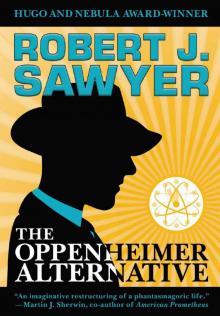 The Oppenheimer Alternative
The Oppenheimer Alternative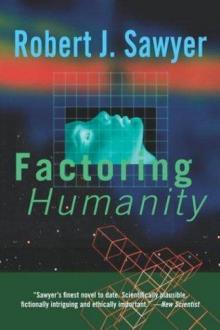 Factoring Humanity
Factoring Humanity The Shoulders of Giants
The Shoulders of Giants Stream of Consciousness
Stream of Consciousness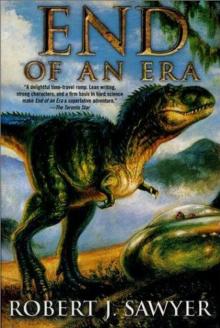 End of an Era
End of an Era The Terminal Experiment
The Terminal Experiment Far-Seer
Far-Seer Mindscan
Mindscan You See But You Do Not Observe
You See But You Do Not Observe Star Light, Star Bright
Star Light, Star Bright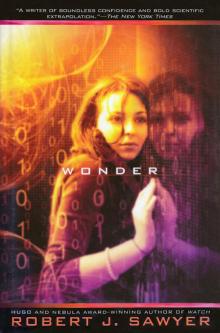 Wonder
Wonder Wiping Out
Wiping Out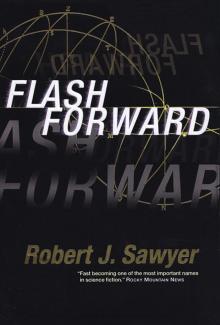 Flashforward
Flashforward Above It All
Above It All Frameshift
Frameshift The Neanderthal Parallax, Book One - Hominids
The Neanderthal Parallax, Book One - Hominids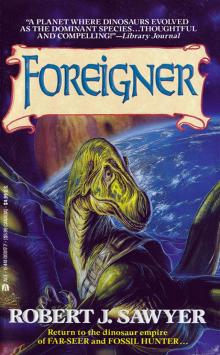 Foreigner
Foreigner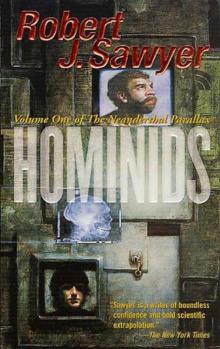 Neanderthal Parallax 1 - Hominids
Neanderthal Parallax 1 - Hominids Relativity
Relativity Identity Theft
Identity Theft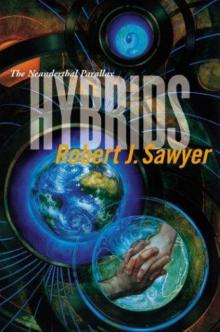 Hybrids np-3
Hybrids np-3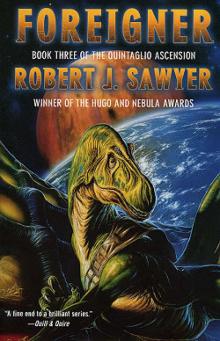 Foreigner qa-3
Foreigner qa-3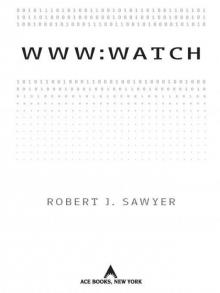 WWW: Watch
WWW: Watch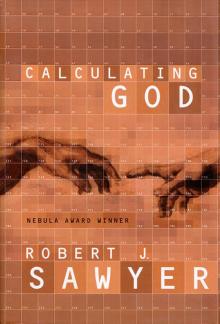 Calculating God
Calculating God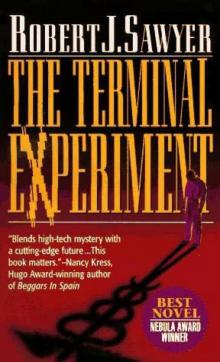 The Terminal Experiment (v5)
The Terminal Experiment (v5) Peking Man
Peking Man The Hand You're Dealt
The Hand You're Dealt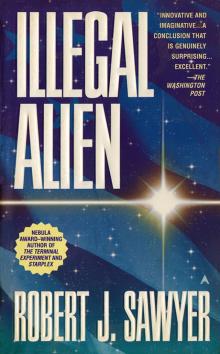 Illegal Alien
Illegal Alien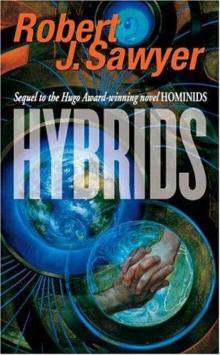 Neanderthal Parallax 3 - Hybrids
Neanderthal Parallax 3 - Hybrids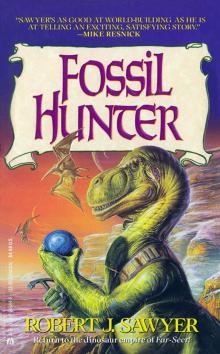 Fossil Hunter
Fossil Hunter WWW: Wonder
WWW: Wonder Iterations
Iterations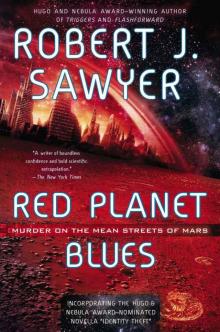 Red Planet Blues
Red Planet Blues Rollback
Rollback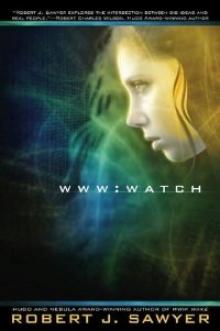 Watch w-2
Watch w-2 Gator
Gator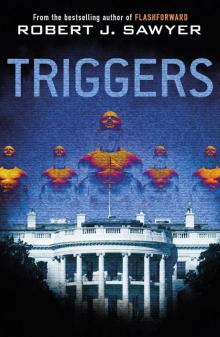 Triggers
Triggers Neanderthal Parallax 2 - Humans
Neanderthal Parallax 2 - Humans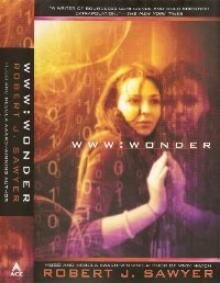 Wonder w-3
Wonder w-3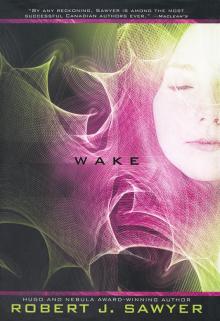 Wake
Wake Just Like Old Times
Just Like Old Times Wake w-1
Wake w-1 Fallen Angel
Fallen Angel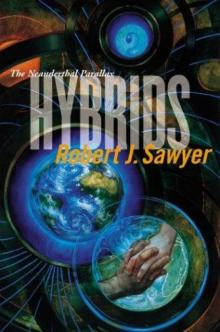 Hybrids
Hybrids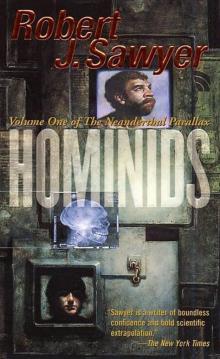 Hominids tnp-1
Hominids tnp-1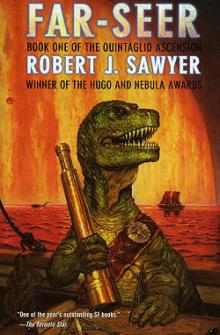 Far-Seer qa-1
Far-Seer qa-1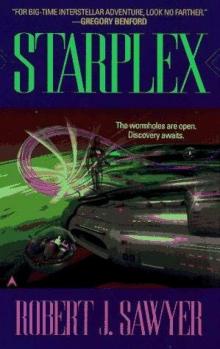 Starplex
Starplex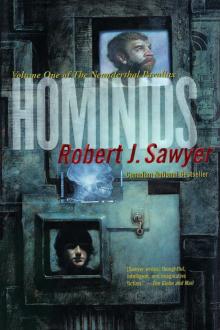 Hominids
Hominids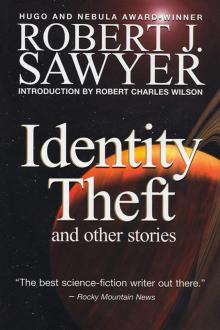 Identity Theft and Other Stories
Identity Theft and Other Stories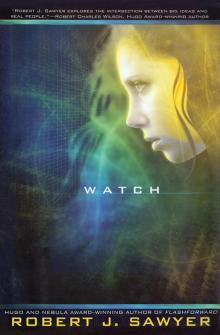 Watch
Watch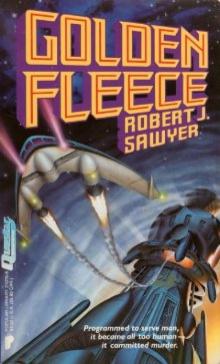 Golden Fleece
Golden Fleece Quantum Night
Quantum Night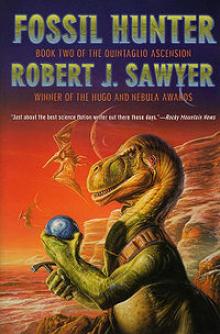 Fossil Hunter qa-2
Fossil Hunter qa-2 Humans np-2
Humans np-2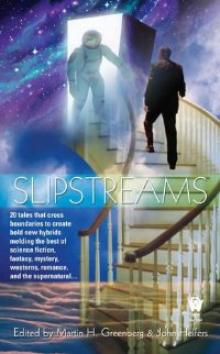 Biding Time
Biding Time